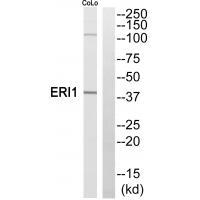
| WB | 咨询技术 | Human,Mouse,Rat |
| IF | 咨询技术 | Human,Mouse,Rat |
| IHC | 咨询技术 | Human,Mouse,Rat |
| ICC | 技术咨询 | Human,Mouse,Rat |
| FCM | 咨询技术 | Human,Mouse,Rat |
| Elisa | 咨询技术 | Human,Mouse,Rat |
| Aliases | 3'-5' exoribonuclease 1; 3'-5' exonuclease ERI1; Eri-1 homolog; Histone mRNA 3'-end-specific exoribonuclease; Histone mRNA 3'-exonuclease 1 |
| Entrez GeneID | 90459; |
| WB Predicted band size | 40kDa |
| Host/Isotype | Rabbit IgG |
| Antibody Type | Primary antibody |
| Storage | Store at 4°C short term. Aliquot and store at -20°C long term. Avoid freeze/thaw cycles. |
| Species Reactivity | Human |
| Immunogen | Synthesized peptide derived from internal of human ERI1. |
| Formulation | Purified antibody in PBS with 0.05% sodium azide. |
+ +
以下是3篇关于ERI1抗体的参考文献,包含文献名称、作者及摘要概括:
1. **文献名称**:*ERI1 interacts with the 3′-end of snoRNA precursors to modulate rRNA processing*
**作者**:Thomas, J. et al.
**摘要**:本研究利用ERI1特异性抗体进行免疫沉淀和Western blot分析,发现ERI1蛋白通过与snoRNA前体的3′端结合,调控rRNA的成熟过程,揭示了其在核糖体生物合成中的关键作用。
2. **文献名称**:*ERI1-mediated degradation of histone mRNA promotes cell cycle progression*
**作者**:Li, Y. et al.
**摘要**:通过ERI1抗体进行免疫荧光和流式细胞术实验,作者发现ERI1通过降解组蛋白mRNA促进G1/S期转换,表明其在细胞周期调控中的新功能。
3. **文献名称**:*ERI1 suppresses antiviral immunity by destabilizing viral RNA in Drosophila*
**作者**:Zhang, L. et al.
**摘要**:该研究利用ERI1抗体检测果蝇模型中的蛋白表达水平,证明ERI1通过其核酸外切酶活性降解病毒RNA,从而抑制宿主的抗病毒免疫反应。
The ERI1 antibody targets the ERI1 (Exoribonuclease 1) protein, a conserved 3’→5’ exoribonuclease involved in RNA metabolism and quality control. ERI1. also known as THEX1 or XRN2. plays dual roles in regulating RNA stability and processing. It degrades unwanted RNAs, including aberrant transcripts and specific microRNA precursors, while also participating in ribosomal RNA (rRNA) maturation. Structurally, ERI1 contains an N-terminal exonuclease domain and C-terminal SAP (SAF-A/B, Acinus, PIAS) motifs, which mediate DNA/RNA binding and protein interactions. Its activity is critical in diverse pathways, such as gene silencing, antiviral defense, and developmental processes.
ERI1 antibodies are widely used in research to study RNA turnover mechanisms, ribosome biogenesis, and ERI1's role in diseases. Dysregulation of ERI1 has been linked to cancers, neurodevelopmental disorders, and viral infections. For instance, ERI1 overexpression in certain tumors correlates with poor prognosis, while its loss-of-function mutations are associated with intellectual disability syndromes. These antibodies enable techniques like Western blotting, immunofluorescence, and immunoprecipitation to localize ERI1 in subcellular compartments (e.g., nucleus, nucleolus) and analyze its interactions with RNA-protein complexes. Validated ERI1 antibodies are essential for exploring its regulatory networks, including crosstalk with RNA interference pathways and stress-responsive RNA decay systems. Their applications extend to model organisms, aiding mechanistic studies in development, aging, and RNA-based therapeutics.
×